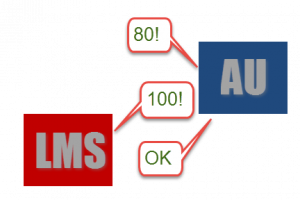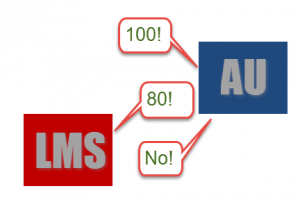The cmi5 specification includes the masteryScore in the State API? Why? What’s it there for? In this article I will attempt to end the confusion around the cmi5 masteryScore.
The passing score problem
Who chooses the passing score? The course developer, or the LMS Administrator? In the cmi5 committee, we have generally leaned towards giving the LMS Administrator the most control. The cmi5 masteryScore is one example. As an LMS Administrator, suppose you purchase content from a vendor, but that vendor has set the passing score at 80. In your environment, however, 80 is not sufficient. You want the passing score to be 100. What can you do?
The cmi5 masteryScore
The cmi5 specification allows the LMS Administrator to modify the passing score (the “masteryScore”). According to section 10 of the spec, the LMS must then write the cmi5 masteryScore to the State API document. Section 10 also says “If the AU issues ‘Passed’ or ‘Failed’ statements, they MUST be based on the masteryScore provided.” So if the LMS passes a masteryScore of 100, and the AU sends a “passed” statement when a score of 80 is achieved, the AU has violated the spec.
Lowering the cmi5 masteryScore
So what about “certified” training? For example, suppose the AU provides some sort of approved certification and needs a score of 100 to get that certification, but the LMS Administrator lowers the cmi5 masteryScore to 80. In this case the AU has the right to refuse to run. Clearly, as a best practice the AU should display a message to the student indicating why it refuses to run so that the issue can be corrected. Note: The AU can also refuse the run if the masteryScore is raised by the LMS… but that’s just being silly.
For more information on cmi5, be sure and check out this blog’s xAPI and cmi5 category.


